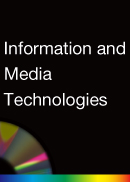Volume 4, Issue 3
Displaying 1-4 of 4 articles from this issue
- |<
- <
- 1
- >
- >|
Media (processing) and Interaction
-
2009Volume 4Issue 3 Pages 655-665
Published: 2009
Released on J-STAGE: September 15, 2009
Download PDF (743K) -
2009Volume 4Issue 3 Pages 666-671
Published: 2009
Released on J-STAGE: September 15, 2009
Download PDF (228K) -
2009Volume 4Issue 3 Pages 672-682
Published: 2009
Released on J-STAGE: September 15, 2009
Download PDF (683K)
Computer Networks and Broadcasting
-
2009Volume 4Issue 3 Pages 683-695
Published: 2009
Released on J-STAGE: September 15, 2009
Download PDF (990K)
- |<
- <
- 1
- >
- >|
